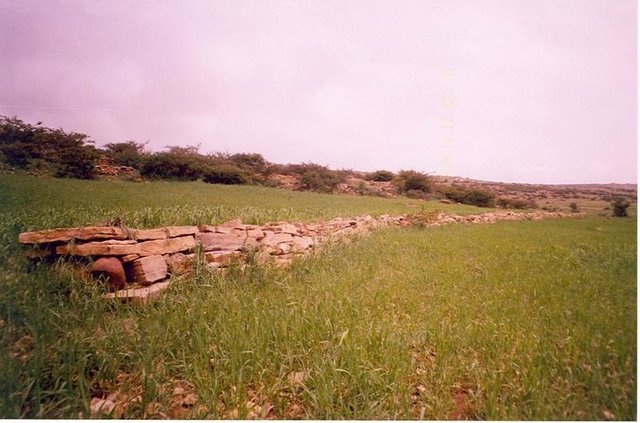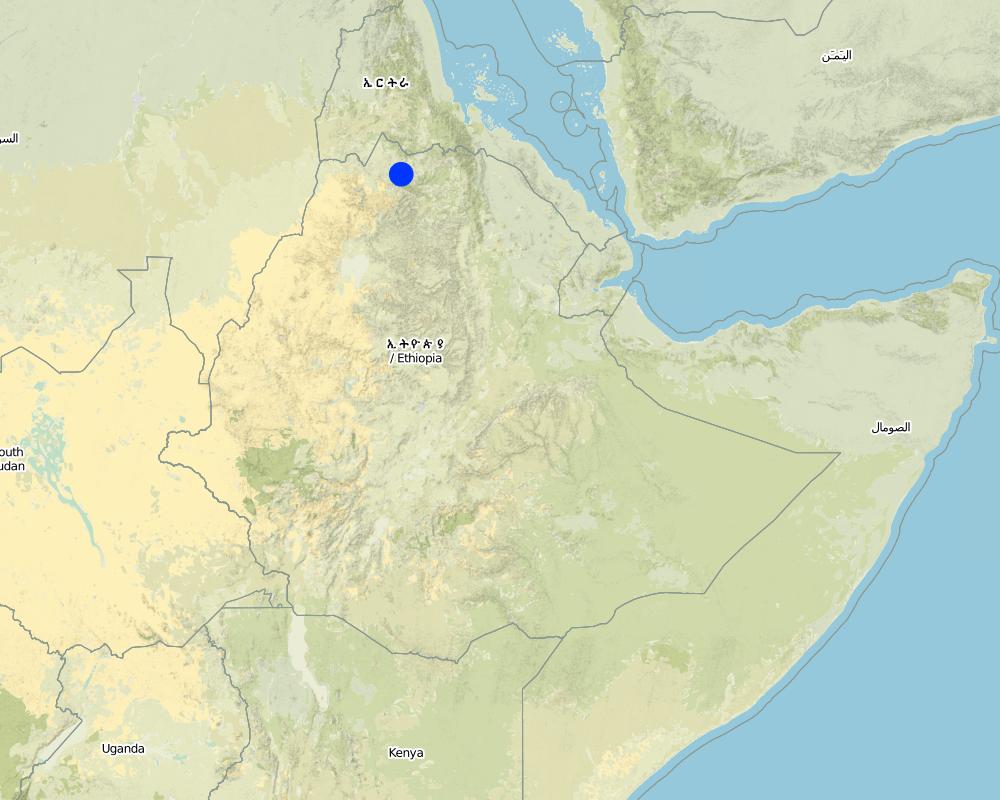Mass mobilization [เอธิโอเปีย]
- ผู้สร้างสรรค์:
- การอัพเดท:
- ผู้รวบรวม: Unknown User
- ผู้เรียบเรียง: –
- ผู้ตรวจสอบ: Fabian Ottiger
approaches_2376 - เอธิโอเปีย
ดูส่วนย่อย
ขยายทั้งหมด ย่อทั้งหมด1. ข้อมูลทั่วไป
1.2 รายละเอียดที่ติดต่อได้ของผู้รวบรวมและองค์กรที่เกี่ยวข้องในการประเมินและการจัดเตรียมทำเอกสารของแนวทาง
วิทยากรหลัก
ผู้เชี่ยวชาญ SLM:
Wolde Gabriel
Tigray Bureau of Agriculture
Mekele
เอธิโอเปีย
1.3 เงื่อนไขที่เกี่ยวข้องกับการใช้ข้อมูลที่ได้บันทึกไว้ผ่านทาง WOCAT
ผู้รวบรวมและวิทยากรหลักยอมรับเงื่อนไขเกี่ยวกับการใช้ข้อมูลที่ถูกบันทึกผ่านทาง WOCAT:
ใช่
1.4 การอ้างอิงถึงแบบสอบถามเรื่องเทคโนโลยี SLM

Stone bund of Tigray [เอธิโอเปีย]
an allignment of stone along the contour line which stabilzes with grass species
- ผู้รวบรวม: Unknown User
2. คำอธิบายของแนวทาง SLM
2.1 การอธิบายแบบสั้น ๆ ของแนวทาง
Mass Mobilization is an approach pursued to implement SLM technologies by organizing land users to undertake SLM activities without incentives being involved.
2.2 การอธิบายอย่างละเอียดของแนวทาง
การอธิบายอย่างละเอียดของแนวทาง:
Aims / objectives: It involves the process of mobilizing and organizing land users in the community (men, women, and youth) who are able-bodied to participate in SLM activities. Land users participating in mass mobilization are required to form SLM groups. Plan for SLM is made at the woreda level and then distributed to kebeles and or sometimes each kebele proposes plan, which is later approved by the woreda. Each member contributes free labor of 20 days every year to undertake land management technologies (past) and this contribution is increased to account for 40 days a year since 2009. The specific objective is to make land users participate in the management of land by implementing improved technologies. SLM measures control runoff and enhance rainfall water percolation. The approach involves organizing land users in SLM groups. Recently two groups are formed known as development team and a sub group called a work team. A development team group comprises 20-30 members while the work team group is 10-15 members. Women and men participate equally in the work groups and in leading the team. Activities undertaken by mass mobilization are mostly (80%) carried out on cultivated lands. Every day the group evaluates its activities. They also participate on the discussions of the plan.
Methods: There is a leader for each group and a production cadre for the groups at Kushet level (the lower administrative unit) who supervises activities of the groups. The groups also work on activities other than SLM. Problems addressed include: soil erosion, deforestation, declining productivity of land, low fertility of soil, low level of participation of the community in SLM activities. All land users in the community are expected to participate in the implementation of the technologies through the mass mobilization approach. The approach area is defined by administrative and as well as watershed boundaries. The Kebele and woreda administrators, woreda specialists and development agents coordinate the implementation and planning of the approach.
2.5 ประเทศ ภูมิภาค หรือสถานที่ตั้งที่ได้นำแนวทางไปใช้
ประเทศ:
เอธิโอเปีย
ภูมิภาค/รัฐ/จังหวัด: :
Laelay Adet, Tahtay A det, Naedir
ข้อมูลเฉพาะเพิ่มเติมของสถานที่ตั้ง:
Tigray, Ethiopia
Map
×2.6 วันที่เริ่มต้นและสิ้นสุดของแนวทาง
ระบุปีที่เริ่ม:
1992
2.7 ประเภทของแนวทาง
- แบบดั้งเดิม/ แบบพื้นเมิอง
2.8 เป้าหมายหรือวัตถุประสงค์หลักของแนวทาง
The Approach focused mainly on SLM with other activities (Pond & dam construction and other water harvesting technologies.)
Aware, organize and initiate land users to participate in SLM activities that aim at controlling soil erosion, which causes land degradation and encouraging land users to contribute free labor for implementing the SLM technologies introduced. The specific objectives are: I) promote the awareness of land users on land degradation problem and II) show the importance of SLM measures which protect cultivated lands from erosion, retain soil moisture and improve fertility of soils.
The SLM Approach addressed the following problems: Soil erosion, deforestation, low productivity low soil fertility, low participation of community in SWC activities.
2.9 เงื่อนไขที่เอื้ออำนวยหรือเป็นอุปสรรคต่อการนำเทคโนโลยีภายใต้แนวทางนี้ไปปฏิบัติใช้
บรรทัดฐานและค่านิยมทางสังคม วัฒนธรรม ศาสนา
- เป็นอุปสรรค
Many holidays are celebrated, and land users do not work on those days.
Treatment through the SLM Approach: Create awareness to work on those days.
การมีไว้ให้หรือการเข้าถึงแหล่งการเงินและบริการ
- เป็นอุปสรรค
Low income of the community
Treatment through the SLM Approach: Create other off farm activities
กรอบแนวทางในการดำเนินการด้านกฎหมาย (การถือครองที่ดิน สิทธิในการใช้ที่ดินและน้ำ)
- เอื้ออำนวย
The existing land ownership, land use rights / water rights moderately helped the approach implementation: There is use right of land users.
ความรู้เกี่ยวกับ SLM การเข้าถึงการสนับสนุนด้านเทคนิค
- เป็นอุปสรรค
Widely spaced bunds do not control inter bund erosion.
Treatment through the SLM Approach: Training to be provided and also promote awareness.
3. การมีส่วนร่วมและบทบาทของผู้มีส่วนได้ส่วนเสียที่เกี่ยวข้อง
3.1 ผู้มีส่วนได้ส่วนเสียที่เกี่ยวข้องในแนวทางนี้และบทบาท
- ผู้ใช้ที่ดินระดับท้องถิ่นหรือชุมชนระดับท้องถิ่น
Tabias
Working land users were work equally divided between men and women. All community member participate equally in decision making.
- รัฐบาลแห่งชาติ (ผู้วางแผน ผู้ทำการตัดสินใจ)
BOA & Regional Adminstration
- องค์การระหว่างประเทศ
3.2 การเกี่ยวข้องของผู้ใช้ที่ดินระดับท้องถิ่นหรือชุมชนระดับท้องถิ่นในช่วงต่างๆของแนวทาง
| ความเกี่ยวข้องของผู้ใช้ที่ดินระดับท้องถิ่นหรือชุมชนระดับท้องถิ่น | ระบุผู้ที่มีส่วนเกี่ยวข้องและอธิบายกิจกรรม | |
|---|---|---|
| การริเริ่มหรือการจูงใจ | ไม่ลงมือ | public meetings: general assembly meeting called for awareness creation and informing about the development plan. |
| การวางแผน | ไม่ลงมือ | Training: train SLM commission members. They plan the activities which is later endorsed by the general assembly. |
| การดำเนินการ | ปฏิสัมพันธ์ | Free labour: 20 days per year |
| การติดตามตรวจสอบหรือการประเมินผล | ไม่ลงมือ | Measurements observation reporting: each activity is measured by the team leader and the other committee members. |
| Research | ไม่มี |
3.4 การตัดสินใจเลือกใช้เทคโนโลยี SLM
ระบุผู้ที่ทำการตัดสินใจเลือกเทคโนโลยีมากกว่าหนึ่งวิธีไปปฏิบัติใช้:
- ผู้เชี่ยวชาญ SLM เป็นผู้ตัดสินใจหลัก ที่ติดตามให้คำปรึกษากับผู้ใช้ที่ดิน
การอธิบาย:
Decisions on the method of implementing the SLM Technology were made by mainly by SLM specialists with consultation of land users
4. การสนับสนุนด้านเทคนิค การสร้างขีดความสามารถ และการจัดการด้านความรู้
4.1 การสร้างขีดความสามารถ / การอบรม
ได้มีการจัดอบรมให้แก่ผู้ใช้ที่ดินหรือผู้มีส่วนได้ส่วนเสียคนอื่น ๆ หรือไม่:
ใช่
ให้ระบุว่าใครเป็นผู้ได้รับการอบรม:
- ผู้ใช้ที่ดิน
- SWC specialists, extensionists/trainers (1), politicians/decision makers (2)
รูปแบบการอบรม:
- กำลังดำเนินการ
- เกษตรกรกับเกษตรกร
- ใช้พื้นที่ทำการสาธิต
- จัดคอร์ส
หัวข้อที่พูด:
On desing, layout & construction methods of SWC technologies, moisture harvesting techniques.
4.2 การบริการให้คำแนะนำ
ผู้ใช้ที่ดินมีการเข้าถึงการรับบริการให้คำปรึกษาหรือไม่:
ใช่
ระบุว่ามีบริการให้คำปรึกษาหรือไม่:
- ไปเยี่ยมชมสถานที่
การอธิบาย/แสดงความคิดเห็น:
Name of method used for advisory service: House hold pack (PADET); Key elements: DA, Contact farmer; 1) Advisory service was carried out through: government's existing extension system; Extension staff: mainly government employees 2) Target groups for extension: land users, technicians/SWC specialists; Activities: Contrubuting free labour; Training, supervising, monitoring & evaluation, creating awarness in the co
Advisory service is quite adequate to ensure the continuation of land conservation activities
4.3 การเสริมความแข็งแกร่งให้กับสถาบัน (การพัฒนาองค์กร)
สถาบันได้รับการจัดตั้งขึ้นมาหรือเสริมความแข็งแกร่งโดยแนวทางนี้หรือไม่:
- ใช่ ปานกลาง
ระบุระดับของสถาบันที่ได้รับการเสริมความแข็งแกร่งหรือจัดตั้งขึ้นมา:
- ท้องถิ่น
ระบุประเภทของการให้ความช่วยเหลือสนับสนุน:
- การสร้างขีดความสามารถ / การอบรม
- อุปกรณ์
4.4 การติดตามตรวจสอบและประเมินผล
การติดตามตรวจสอบและประเมินผลเป็นส่วนหนึ่งของแนวทางหรือไม่:
ใช่
ความคิดเห็น:
bio-physical aspects were ad hoc monitored through measurements; indicators: soil depth, change in land use and land cover
technical aspects were regular monitored through measurements; indicators: dimensions and quality
economic / production aspects were ad hoc monitored through measurements; indicators: increase in production per unit area
area treated aspects were regular monitored through measurements; indicators: extent of work done
no. of land users involved aspects were regular monitored through measurements; indicators: number of participating land users in the work
management of Approach aspects were regular monitored through observations; indicators: impacts and changes
There were few changes in the Approach as a result of monitoring and evaluation: At initial stage of the implementation of the approach the cummunity members were contributing their free labour 3 month per year for SWC activities, but through evaluation it has been changed to 20 days/year.
5. การสนับสนุนด้านการเงินและวัสดุอุปกรณ์
5.1 ระบุงบประมาณประจำปีสำหรับแนวทาง SLM นี้
ถ้าหากว่างบประมาณประจำปีไม่เป็นที่ทราบแน่นอน ให้ระบุช่วงลงไป:
- 2,000-10,000
แสดงความคิดเห็น (แหล่งของการระดมทุน ผู้บริจาคคนสำคัญ):
Approach costs were met by the following donors: government (Training and work tools support): 5.0%; local community / land user(s) (Labor and material): 95.0%
5.2 การสนับสนุนด้านการเงิน / วัสดุอุปกรณ์ให้แก่ผู้ใช้ที่ดิน
ผู้ใช้ที่ดินได้รับการสนับสนุนด้านการเงิน / วัสดุอุปกรณ์ไปปฏิบัติใช้เทคโนโลยีหรือไม่:
ใช่
5.3 เงินสนับสนุนสำหรับปัจจัยนำเข้า (รวมถึงแรงงาน)
- อุปกรณ์
| ระบุปัจจัยนำเข้าที่ได้รับการสนับสนุน | เห็นด้วยระดับไหน | ระบุเงินสนับสนุน |
|---|---|---|
| เครื่องมือ | ได้รับการช่วยเหลือทางการเงินบางส่วน | |
- การเกษตร
| ระบุปัจจัยนำเข้าที่ได้รับการสนับสนุน | เห็นด้วยระดับไหน | ระบุเงินสนับสนุน |
|---|---|---|
| เมล็ด | ได้รับการช่วยเหลือทางการเงินบางส่วน | |
- โครงสร้างพื้นฐาน
| ระบุปัจจัยนำเข้าที่ได้รับการสนับสนุน | เห็นด้วยระดับไหน | ระบุเงินสนับสนุน |
|---|---|---|
| Community infrastructure | ได้รับการช่วยเหลือทางการเงินแบบเต็ม | |
ถ้าแรงงานโดยผู้ใช้ที่ดินเป็นปัจจัยนำเข้าที่มีอยู่มากมาย ระบุด้วยว่าเนื่องจาก:
- สมัครใจ
5.4 เครดิต
มีการจัดหาเครดิตมาให้ภายใต้แนวทาง SLM หรือไม่:
ไม่ใช่
6. การวิเคราะห์ผลกระทบและการสรุป
6.1 ผลกระทบของแนวทาง
ช่วยให้ผู้ใช้ที่ดินนำเอาเทคโนโลยี SLMไปใช้และบำรุงรักษาสภาพไว้ได้หรือไม่:
- ไม่ใช่
- ใช่ เล็กน้อย
- ใช่ ปานกลาง
- ใช่ อย่างมาก
To conserve their individual land by them selves.
Did other land users / projects adopt the Approach?
- ไม่ใช่
- ใช่ เล็กน้อย
- ใช่ ปานกลาง
- ใช่ อย่างมาก
In some jfood for jwork & chas for work SWC activities they apply this approach to contribute some perventage of the activities as a free labour.
6.3 ความยั่งยืนของกิจกรรมของแนวทาง
ผู้ใช้ที่ดินสามารถทำให้สิ่งต่างๆ ที่ได้ปฏิบัติใช้โดยแนวทางนี้ยั่งยืนได้หรือไม่ (โดยไม่มีการสนับสนุนจากภายนอก):
- ใช่
6.4 จุดแข็งและข้อได้เปรียบของแนวทาง
| จุดแข็ง / ข้อได้เปรียบของแนวทางในทัศนคติของผู้รวบรวมหรือวิทยากรหลัก |
|---|
| Wokring in group improves the management of large area of cultivated lands in short period (How to sustain/ enhance this strength: More training, awareness and study tour opportunities to be provided. Provision of hand tools.) |
| Easy transfer of technology possible |
6.5 จุดอ่อน / ข้อเสียเปรียบของแนวทางและวิธีในการแก้ไข
| จุดอ่อน / ข้อเสียเปรียบในทัศนคติของผู้รวบรวมหรือวิทยากรหลัก | สามารถแก้ไขปัญหาได้อย่างไร |
|---|---|
| Unwillingness from some land users to work in groups | Convincing land users. |
7. การอ้างอิงและการเชื่อมต่อ
7.1 วิธีการหรือแหล่งข้อมูล
- ไปเยี่ยมชมภาคสนาม การสำรวจพื้นที่ภาคสนาม
- การสัมภาษณ์กับผู้ใช้ที่ดิน
ลิงก์และโมดูล
ขยายทั้งหมด ย่อทั้งหมดลิงก์

Stone bund of Tigray [เอธิโอเปีย]
an allignment of stone along the contour line which stabilzes with grass species
- ผู้รวบรวม: Unknown User
โมดูล
ไม่มีโมดูล


